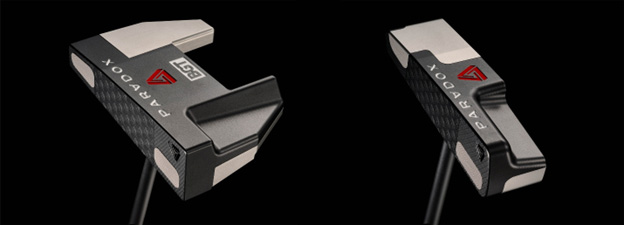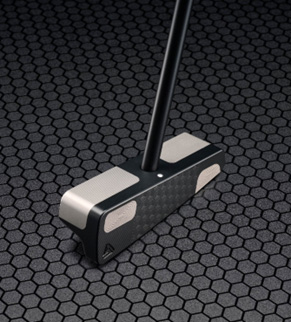Paradox™ Putters – A Dynamic Leap in Putter Technology
By Dr. Barry Lotz, J.D., Ph.D.
In the constantly evolving world of golf equipment, few putters genuinely redefine how the club interacts with a golfer’s stroke. The Paradox™ Putter, built around a unique and scientifically sound approach to dynamic balance, offers one of the most compelling technological advancements I’ve seen in recent years.

Moving Beyond Marketing Myths
Terms like zero-torque, face-balanced, and center of gravity alignment have become overused—often reduced to marketing clichés. Many manufacturers promote their putters based on static attributes: how they sit at address, their claimed balance point, or their purported resistance to face rotation. While these claims may be held on paper, they rarely account for the real-world physics of a putting stroke in motion.
The truth is that all putters, regardless of balance claims, undergo torque and deflection during the stroke. The swing is a dynamic motion—and to evaluate performance, we must assess dynamic behavior, not just static design.
Principal Axis Technology: What Sets Paradox Apart
Paradox Putters depart from the conventional by introducing what they call Principal Axis Technology™—and the performance results merit attention.
At its core, this technology aligns the Principal Axis of Inertia—not merely the center of gravity—with the motion of the putting stroke. This subtle but crucial distinction means the putter resists unwanted twisting dynamically during the stroke, not just while resting in your hands at setup.
Moreover, the internal weighting design—high in the toe and low in the heel—intentionally shifts the putter’s mass along this axis to complement the stroke’s arc and maintain face stability. This is not face-balancing in the traditional sense; it’s a more advanced form of stroke-matched inertia control.
On-Course Testing and Player Feedback
My testing team and I evaluated only the Paradox Mallet center-shafted model equipped with BGT’s Stability Tour Shaft. Across the board, this putter demonstrated measurable performance improvements:
- Increased Make Percentage: Players holed more putts across varying lengths.
- Improved Miss Proximity: Off-center strikes—especially those struck on the toe or heel—finished 15–25% closer to the hole compared to leading models.
- Earlier Roll Initiation: The Paradox consistently achieved pure roll 20% sooner, translating to tighter dispersion and better distance control.
This wasn’t just anecdotal. These outcomes were observed with mid-handicap players, elite amateurs, and professional-level testers.
The Paradox Lineup consists of two models:
Paradox™ Mallet (Center Shafted):
Engineered for players who value forgiveness and alignment. This model features a CNC-milled aluminum body with heel and toe steel weighting—optimized for square-face retention during the stroke.

A sleeker, more traditional profile that maintains the same performance geometry and shaft integration. Particularly impressive for golfers who favor a more compact look without sacrificing dynamic balance.
Common Design Elements:
- Principal Axis Technology™
- CNC-milled aluminum + steel weight construction
- Mid-size, non-taper grip
- Center-shafted geometry for cleaner alignment
- BGT Stability Tour Shaft for minimal face deflection
A Paradigm Shift, not a Gimmick
While most putters emphasize alignment aids or static claims, Paradox shifts the focus to how a putter behaves while in motion. This is where real strokes are made—or missed.
The engineering behind the Paradox™ lineup shows what’s possible when performance is measured in motion rather than by address position. It’s not about perfect balance at rest—it’s about sustained stability and correction during the stroke.
Final Thoughts
Confidence on the greens begins with consistency. The Paradox Putter delivers both—through advanced design and real-world results. This isn’t just a new putter. It’s a new category of putting performance.
For golfers looking to gain a genuine edge—especially those frustrated by subtle mishits or inconsistent rolls—the Paradox may be the most important upgrade they can make.
$699.00 www.bgolftech.com
Barry Lotz, J.D., Ph.D. is the director of the Professional Golf Teachers Association of America. Visit www/facebook.com/PGTAA to see all the latest mental strategies, travel and equipment reviews. Currently he also works with between 10 to 12 PGA Tour players on the mental side of golf.
He is a member of the Golf Writers Association of America and serves both as a Consultant and Mediator to the golf industry. He is also the author of numerous books, including “333 Best Web Sites for Golfers” and his previous book, “How to Build Business Relationships through Golf”, is still in the Top Ten Golf Business Book’s best seller list. His current books, “The Right Mind for Golf”, “The Right mind for Putting”, The Right Approach to Golf”, and “The Bank Nine – Embracing Golf as a Senior”, is available on at the Torrey Pines Golf Course or https://www.pgtaa.com/product-category/books-and-apparell/.

